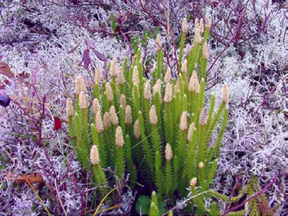 New research on how ozone affects plants and their reproduction may be the
key to figuring out what happened to trigger Earth’s largest extinction
event, which occurred around 250 million years ago. The new findings may also
prove useful for determining atmospheric conditions long ago.
New research on how ozone affects plants and their reproduction may be the
key to figuring out what happened to trigger Earth’s largest extinction
event, which occurred around 250 million years ago. The new findings may also
prove useful for determining atmospheric conditions long ago.Plants such as this one from South Georgia Island in South America, beneath the ozone hole, create more pigment to protect their spores when bombarded with extra ultraviolet light. Large volcanic eruptions could enhance ozone holes, and leave evidence in spores in the fossil record. Courtesy of Barry Lomax.
The end of the Permian saw the biggest wipeout of life forms of all time, with the disappearance of 90 percent of all species before the beginning of the Triassic. The extinction roughly coincided with the eruption of the Siberian Traps, a voluminous outpouring of volcanic materials that emitted carbon dioxide and other gases.
One angle of proof to pin extinctions on a volcanic eruption “is just showing that the timing is right. Once you’ve got that established,” says Paul Wignall of the University of Leeds in the United Kingdom, the remaining angle is “how did it do it?”
The carbon dioxide from the massive eruption would have contributed to global warming at the time; the halogens released, such as chlorine and fluorine, would have damaged the ozone layer. A large ozone hole would allow more ultraviolet (UV) radiation to reach Earth’s surface — ultimately affecting land plants and animals.
The effects of such UV exposure could be extreme. Using present-day examples with an eye to the past, Barry Lomax, a research associate at the University of Sheffield in the United Kingdom, and his co-workers studied plants on South Georgia Island, located east of South America’s tip, beneath the present-day ozone hole. As presented on Aug. 10, in Calgary, Alberta, at the joint meeting on Earth System Processes held by the Geological Society of America and the Geological Association of Canada, they found that modern relatives of prehistoric plants, Lycopodium annotinum and Selaginella selaginoides, react to excess UV rays by changing key proteins that protect spores from damage.
The modern plants showed “a marked increase in UV-screening pigments,” up to a threefold increase that matched increased ozone exposure, says David Beerling, who leads the research program. The plants “clearly have responded consistently to this change in the stratospheric ozone layer” with changes to “some of their component molecules,” Beerling says. But the key will be finding whether the proteins that triggered the pigment changes can survive in the fossil record (pigments do not). “Samples are being run as we speak,” he says, from fossils preserved from the Permian-Triassic boundary.
Direct evidence of ozone depletion “is very hard to find” in the fossil record, but if the pigment-changing molecules survive, they would be an apt biomarker, says Wignall, who co-convened the meeting session. The team’s idea is “a novel approach, and they’re only halfway there,” he says.
Lomax and his co-workers cite recent reports of twisted and mutated spores from similar plants at the end of the Permian; such changes could be attributable to UV effects. Other researchers have pointed out that it is difficult to prove whether plants living at the time actually mutated to extinction, instead of surviving the UV bombardment. Still, the changes in spore proteins could be a possible proxy for determining atmospheric conditions for other “deep time” periods as well, says Jeff Kiehl of National Center for Atmospheric Research in Boulder, Colo. The spores would serve as proxies in the same way that fossils of small single-celled phytoplankton in the oceans provide proxies for ocean chemistry and temperature.
Naomi Lubick

